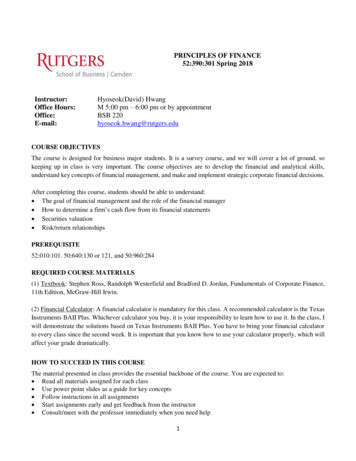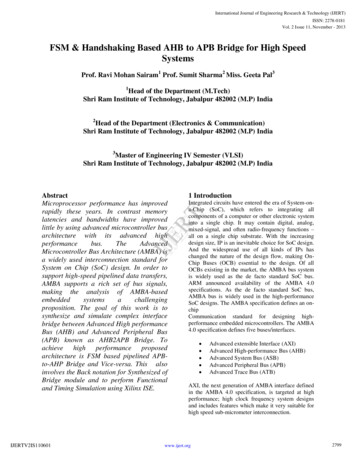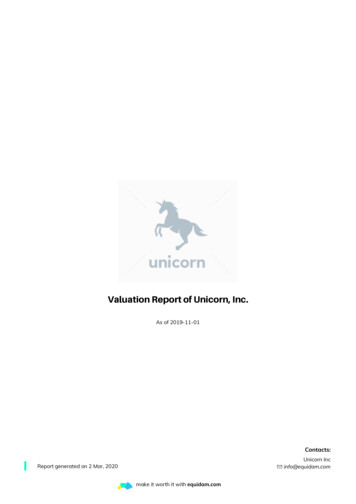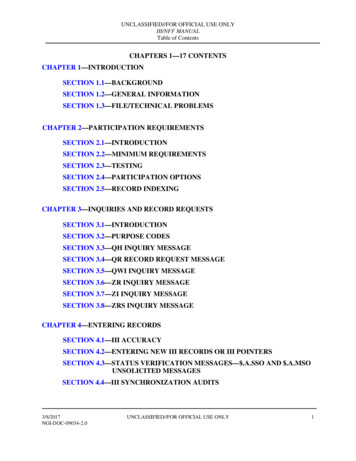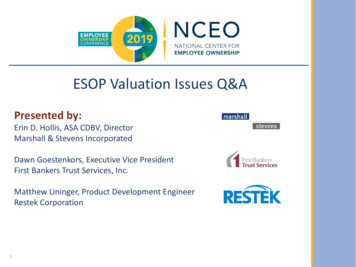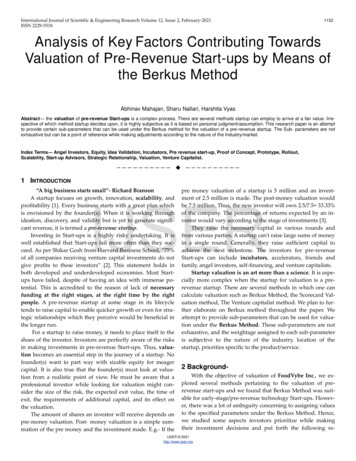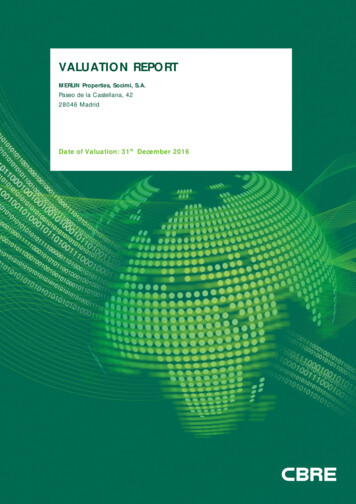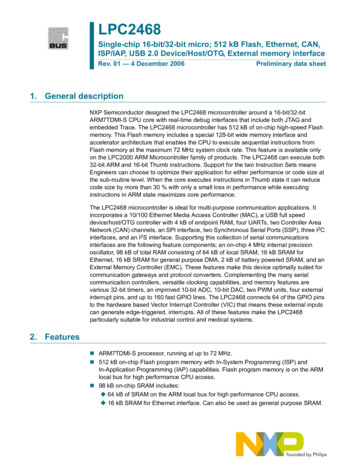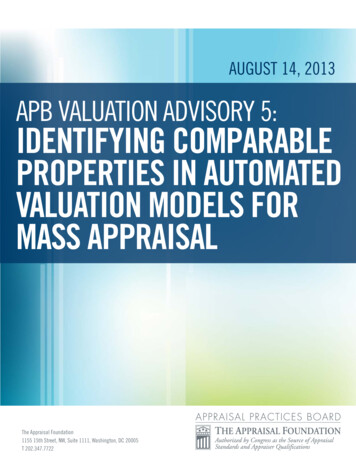
Transcription
AUGUST 14, 2013APB VALUATION ADVISORY 5:IDENTIFYING COMPARABLEPROPERTIES IN AUTOMATEDVALUATION MODELS FORMASS APPRAISALThe Appraisal Foundation1155 15th Street, NW, Suite 1111, Washington, DC 20005T 202.347.7722
APB Valuation Advisory #5Identifying Comparable Properties InAutomated Valuation Models for Mass AppraisalThis communication is for the purpose of issuing guidance on recognized valuationmethods and techniques. Compliance with such guidance is voluntary, unless mandatedthrough applicable law, regulation, or policy.Date Issued: August 14, 2013Application: Automated Valuation Models in Mass AppraisalIssue: As part of its ongoing responsibilities, the APB is tasked with identifying whereappraisers and appraisal users believe additional guidance is required. One such issueidentified by the APB is identifying comparable properties. Comparability analysis is afundamental study in determining property value. This analysis involves a side-by-sideexamination of physical and transaction characteristics of the identified comparable propertiesrelative to the subject. The reliability of this valuation technique relies heavily on the properselection of suitable comparable properties.The APB discovered in developing guidance on Identifying Comparable Properties that separateguidance on Identifying Comparable Properties in Automated Valuation Models for MassAppraisal was required.This guidance discusses the terms and definitions associated with a comparable property, thecharacteristics generally considered for determining comparability; and the degree of suitabilityof a property as a comparable when using automated valuation and mass appraisal models.Additionally, a general overview of mass appraisal’s automated collateral comparable selectionprocess is included.The proposed guidance addresses the sales comparison method - direct market models usingsales transactions. Model specification and model calibration are discussed. The guidanceAPB Valuation Advisory #5 - Identifying Comparable Properties InAutomated Valuation Models for Mass Appraisal 2014 by The Appraisal Foundation. All Rights Reserved.1
provides sample model structures using the direct market method. Comparable sales selection isdiscussed in detail.Lastly, the guidance examines appraisal uniformity based on the equity comparison method.Subject Matter Experts: The Appraisal Practices Board and The Appraisal Foundation wish toexpress our sincere gratitude to each of the following Subject Matter Experts for volunteeringtheir time and expertise in contributing to this document:Grant W. Austin – New Smyrna Beach, FloridaAnthony M. Graziano – Toms River, New JerseyMichael Ireland – Bloomington, IllinoisKaren Oberman – Clive, IowaJo Anne Traut – Brookfield, WisconsinAPB Liaisons: Guy Griscom and John S. MarrazzoIdentifying Comparable Properties forAutomated Valuations in Mass Appraisal ModelsTABLE OF CONTENTSSectionIssuePageIIntroduction3IISales Comparison Method – Direct Market Models using SalesTransactions3IIISample Model Structures – Direct Market Method5IVSales Comparison Method – Comparable Sales Selection7VAppraisal Uniformity – Equity Comparison Method18VIDefinitions19VIISuggested Further Reading21NOTE: This Valuation Advisory includes examples that utilize proprietary software applications.Neither the Appraisal Practices Board nor The Appraisal Foundation endorses or recommendsutilization of the particular software applications referenced in this document. They have beenincluded to assist in the illustration of the applicability of such applications.APB Valuation Advisory #5 - Identifying Comparable Properties InAutomated Valuation Models for Mass Appraisal 2014 The Appraisal Foundation2
I.Introduction12345678The terms Mass Appraisal Models1 and Automated Valuation Models (AVM)2 involve the use ofcomparable properties in their market analysis methods. The term AVM is used in this guidelineto represent both mass appraisal and automated valuation models keeping the focus on datarequirements used in the development of valuation models. “The development of an AVM is anexercise in the application of appraisal principles and techniques, in which data are analyzedfrom a sample of properties to develop a value prediction model that can be applied to a similarpopulation of properties that represent subject properties. These may be either individualproperties of interest or all properties that meet the requirements of the model.”391011121314151617The Sales Comparison Approach is applied using the AVM via several methods, the twodiscussed in this guideline are: 1) direct market models; and 2) comparable sales models. A thirdmethod used and of interest to appraisers doing ad valorem work is the equity comparablemethod. The direct market models and the comparable sales models begin with the validation ofall transaction data to be used in developing the model. These sales include transactions deemedas arms-length, as they are the most credible. When specific market segments are influenced by“distress” sales (e.g., short sales and foreclosures) these transactions may be used in the modeltraining set. A model training set in this guideline consists of data used to discover predictiverelationship in the market place.1819202122Income approach models require analyzing leases (rents and occupancy), expense ratios, andcapitalization rates in completing the model specification phase. Validation of the comparableincludes verification of the property characteristics for each transaction at the time of itsconsummation. Readers of this document may also want to review the “sister” document,Identifying Comparable Properties, as there is some overlap of definitions and concepts.2324252627Users and readers of this guidance are encouraged to keep the methods and techniques describedin context with their specific scope of work, see STANDARD 6, USPAP4. An AVM developedfor use in collateral, or portfolio valuation will have a different scope of work than an AVMdeveloped for ad valorem use. Awareness of administrative rules, case law, statutoryrequirements and client request are required.II.282930Sales Comparison Method Direct Market Models using Sales TransactionsPrimary for developing a direct market model are model specification5 and model calibration6.Model specification involves indentifying all property characteristics to use in the model. Thesecharacteristics include features that represent location, physical, economic, and legal interest.1IAAO. 1997. Glossary for property appraisal and assessment. Chicago: IAAO.Ibid3IAAO, 2003 Standard on Automated Valuation Models (AVMs) page 5, Chicago4UNIFORM STANDARDS OF PROFESSIONAL APPRAISAL PRACTICE (USPAP) 2012-13 Edition page U495IAAO, 1997. Glossary for property appraisal and assessment. Chicago, IAAO.6Ibid2APB Valuation Advisory #5 - Identifying Comparable Properties InAutomated Valuation Models for Mass Appraisal 2014 The Appraisal Foundation3
31323334Accurate property characteristics are important in model development as each sale is processedduring calibration via a comparative analysis that relies on measuring price changes as theproperty characteristics change. The sales used for calibration of direct market models also areused in the comparable sales method, as the adjusted comparables.35363738394041Accurate property characteristics and sales validation provide the cornerstone for achievingcredible results in the development of an AVM. The purpose of automated valuation models isto estimate a value for many properties by using an iterative process of data and analysis. Theinfluence of market areas and neighborhoods are captured using proximity variables, be it thestreet level, neighborhood, or market area. Market influences from another city, state, orcountry, are addressed when specifying the model. When properly specified and calibrated,these variables will identify and account for the influence of physical location on value.424344454647484950515253When an AVM is specified using only sales in a specific neighborhood, the model is onlyapplicable to properties within the specific boundaries. If a subject property were located in aneighborhood different from where the comparables are located, the credibility of the AVMsuffers due to the fact the AVM may not identify or measure any of the economic influencesspecific to the subject. The concept of using locational similarities is helpful in identifying alllocal effects in the marketplace that have influence on a given subject’s property value. To drawa distinction, not all neighborhoods or market areas will provide a sufficient sample oftransactions for each and every subject property. When the pool of market transactions isinsufficient, identification and selection of comparable requires the use of additional physicalproperty characteristics. When market transactions are insufficient in number to provide credibleresults, selecting transactions from a location outside of the subject’s neighborhood, or marketarea is often required.The table below provides a focus regarding example proximities that influence the value direction. These proximitiesvariables when specified in the AVM are useful in selecting properties with similar market influences. Adjusting valueswhen the influence is not present or not entirely similar may be required. Markets are dynamic thus any positive canbecome negative and vise-versa, Table 1 provides an illustration.TABLE l54555657Examples of Location and Proximity Characteristics with a Value InfluenceSample Proximity CategoriesEmploymentPublic rses Parks AirportsRailHighway --- /- /- /- The previous discussion on the development of the AVM focused on specifying the modelspecifically for variations due to a subject property’s proximity or location. Model specificationincludes the use of physical characteristics as well. The AVM must be capable of valuing asubject that is different in size, age, condition, style, exterior wall type, quality, and utility asAPB Valuation Advisory #5 - Identifying Comparable Properties InAutomated Valuation Models for Mass Appraisal 2014 The Appraisal Foundation4
5859606162examples. When the AVM is to value vacant land, features such as lot size, frontage, depth,view, topography, ingress, egress, lot shape, lot location, (e.g., corner lot, interior lot) land use,zoning, etc. are characteristics to be considered. Each property characteristic specified in theAVM is calibrated using the known transaction prices as the dependent variable upon which allmarket adjustments are based for each of the specified property characteristics.63646566676869707172Property characteristics used in an AVM measure the economic influences, and how eachcontributes to the value of a subject property. User confidence in the credibility of AVM valueswill suffer when an important property attribute is either missing, incorrectly specified orcalibrated during the modeling process. When working with property data it is important forappraisers to learn about data exploration techniques, to avoid problems with missing data, andmodels that have been mis-specified, resulting in irrational and unexplainable calibration of avariable. The number of subject properties to which the AVM is applicable is the “hit rate.”7 Ifa subject is outside of acceptable parameter ranges for location or property characteristics, theAVM will not possess sufficient comparability to value the subject property with a high degreeof accuracy or credibility.III.Sample Model Structures - Direct Market Method737475Direct market models are expressed in one of three math structures: additive, multiplicative, orhybrid. The skill and experience level of the analyst and software availability are also factorsinvolved with choice of the model structure. The additive model is the most common.76Additive models have the form:77MV B0 (B1 X1) (B2 X2) (Bxx Xxx) 78 MV is the dependent variable (Sale Price, or Sale Price per Unit);79 B0 - is a constant dollar amount;8081 Xi - represents the independent variables (property characteristics) in the model: Xirepresents X1, X2 etc. from above model notation, and8283 Bi are corresponding adjustment rates or “coefficients” applied to Xi, Bi represents B1, B2etc. from the above model notation848586In the model above MV also known as the dependent variable and is either “sale price” or “saleprice per unit.” When modeling income the dependent variable is “income” or “income perunit.”87In a multiplicative model, the contribution of the variables are multiplied rather than added:88MV R0 * (X1 B1) * (X2 B2) *(Xxx Bxx) 7IAAO, 2003 Standard on Automated Valuation Models (AVMs) page 28, ChicagoAPB Valuation Advisory #5 - Identifying Comparable Properties InAutomated Valuation Models for Mass Appraisal 2014 The Appraisal Foundation5
89909192939495Multiplicative models consist of a base rate (R0) and percentage adjustments. Base rates areexpressed as dollars, or a percentage (e.g., vacancy rate, expense ratios, GIMs, OARs). Themultiplicative model advantages include the ability to capture curvilinear and interactiverelationships and to make adjustments proportionate to the value of the property appraised.Multiplicative models can be calibrated using linear regression software; doing so will requirethe variables to be converted to a logarithmic format for calibration. Non-linear regression canbe used also and does not require the logarithmic transformation.969798Hybrid models are a combination of additive and multiplicative models. Hybrid models allowspecifications that separate value into buildings, land, and “other” components (e.g.,outbuildings). The model format is:99MV πGQ x [(πBQ x Σ BA) (πLQ x Σ LA) Σ OA]100 MV is the estimated market value;101102 πGQ is the product of general qualitative terms (e.g., location influences marketconditions);103104 πBQ is the product of building qualitative terms: (e.g., quality, condition, wall types, andstyles);105 ΣBA is the sum of building additive terms; (e.g., total living area, total rooms, baths, FP’s);106 πLQ is the product of land qualitative terms: (e.g., view, traffic, topography, egress);107 ΣLA is the sum of land additive terms: (e.g., lot frontage, lot area); and108 ΣOA is the sum of other additive terms: (e.g., pools, out buildings, accessory structures).109110111A full discussion on the topic of model structures is available in the IAAO Standard on AVMs.8Calibration of the models, developing coefficients, or rates of adjustment may be completedusing applications like linear multiple regression analysis (MRA) and non-linear MRA.112113114115116117Automated valuation models require data representative of the full range of transaction pricesand associated property characteristics in a defined area. The sold properties used for marketcomparison, and unsold subjects to be valued must represent comparable segments of the marketpopulation. The AVM relies on market data from standardized property coding methods.Collectively all the validated sold properties represent the potential comparables for any knownsubject.118119120Model performance and validation is also an important step to having a direct model that willproduce credible results. The IAAO Standard on Automated Valuation Models (AVMs) may bereferenced for completing this step.989Ibid pages 10-12Ibid page 24APB Valuation Advisory #5 - Identifying Comparable Properties InAutomated Valuation Models for Mass Appraisal 2014 The Appraisal Foundation6
IV.Sales Comparison Method – Comparable Sales Selection121122123124125126As with single property appraisal, Automated Valuation Models (AVMs) rely on arms-lengthsales primarily to adjust a model to local real estate trends. In market areas where propertieshave a high degree of homogeneity, the AVM will produce value estimates with a high degree ofprecision. Areas where the market is heterogeneous the error term of the AVM is usually higherand not as precise. The sales comparison model is a familiar format to appraisers and expressedas follows:127MV SPc ADJc, where:128 MV Market Value;129 SPc Sale Price of the comparable; and130 ADJc adjustment to the comparable .131132133134135136As the integrity of the data used to calibrate an AVM decreases, the precision and accuracy ofthe value estimate is often deemed less credible. Using automation to select comparableproperties that will produce credible and reliable value estimates is the challenge of the AVM.USPAP compliance is attainable using automated selection methods (see the discussion on dataverification). The following will provide the steps leading to selecting the most comparableproperties for a single subject.137138139140141142143144Step (1) is selecting the best comparables. Numerous techniques are used in practice with the“exception, or sorting techniques” being most popular. The most efficient and objectivetechnique is the use of a distance metric that assigns a dissimilarity index to each sale in the file.The more similar a comparable property is to the subject, the lower its metric value“dissimilarity index.” Two indexes used frequently are the “Squared Euclidean distancemetric”10 and the “Minkowski metric” (differences are not squared). These distance metrics relyon a selection model or algorithm specified by the appraiser to find the most comparableproperty (e.g., sales, rents, expenses) used for comparison to a subject.145The Euclidean distance metric is expressed as:112146147Where:148 Σ the summation of all the weighted squared attribute difference;149 Wj a weight assigned by the user to the j-th attribute;1011IAAO Glossary for Property Appraisal and Assessment, IAAO.orgFundamental of Mass Appraisal, IAAO, 2011 p 144APB Valuation Advisory #5 - Identifying Comparable Properties InAutomated Valuation Models for Mass Appraisal 2014 The Appraisal Foundation7
150 Ssj the value of the j-th attribute for the subject;151 Xij the value the j-th attribute of the comparable property;152 σj the standard deviation of the j-th attribute for the comparables;153 2154 K the number of attributes over which comparability is defined. squaring creates an absolute scale of difference; and155156157158Assigning weights to the selection characteristics is the most difficult aspect of using adissimilarity index. The higher the weight the greater the importance assigned to thecharacteristic. As the weight on a characteristic is increased, the algorithm will allow less of adifference in that characteristic.12159160Tables 2 and 3 on the following page provide an example demonstrating how the metriccalculation works:12Ibid144APB Valuation Advisory #5 - Identifying Comparable Properties InAutomated Valuation Models for Mass Appraisal 2014 The Appraisal Foundation8
Table 2:AttributeSubjectComparable #1Example of Euclidean Distance Metric -- Comparable No 671-1.66672.7778Living Area6.4585The sum of the standardized, weighted squared differences is 6.4585based on the three selection attributes chosenTable 3:AttributeSubject Comparable #2Example of Euclidean Distance Metric -- Comparable No .66672.7778Living AreaThe sum of the standardized, weighted squared differences is 5.7046 based on the three selection attributes chosen.APB Valuation Advisory #5 - Identifying Comparable Properties InAutomated Valuation Models for Mass Appraisal 2014 The Appraisal Foundation95.7046
161162163Comparable No. 2 is closer in size to the subject and has a metric score of 5.7046, lower than thescore of 6.4585 for Comparable No. 1. Each sale would require the same number of adjustmentsbut the total adjustment for Comparable No. 2 would be less than for Comparable No. 1.164165Minkowski metric differs from the Euclidian, in that absolute differences are used rather thansquared differences making a smaller metric scale13.166167168Division by the standard deviation also provides the algorithm the ability to standardize themagnitude in data differences that are measured or recorded in different scales, similar to the useof Z-scores.169170171Once a distance metric is calculated for all potential comparables, the properties are sorted basedon their metric. The comparables most similar to the subject are those with the lowest metricvalue.172173174175176177178179180181182The higher the weight on an attribute the more important that property attribute is in the selectingsimilar properties. Initially weights are assigned to those property attributes identified as themost influential in explaining why prices change from property to property. Indicators helpfulwith weighting include; regression coefficients (weights), beta coefficient, correlationcoefficients, and T-statistics. Assigning weights forces the algorithm to select comparableswhose attributes are most similar to the subjects. The appraisers, skill, knowledge, andexperience also play a role in knowing how much weight to assign an attribute. Selectingcomparables without disclosing the attribute(s) that are most important has been the practiceprimarily used by appraisers. Using a dissimilarity index exposes the importance of specificattributes in contrast to attributes considered less important having lower weights or no weightassigned.18313Ibid145APB Valuation Advisory #5 - Identifying Comparable Properties InAutomated Valuation Models for Mass Appraisal 2014 The Appraisal Foundation10
184Comparable Sales Selection Method185Table 4: Provides a Distance Metric, Weighting Example, from the NCSS Statistical Software14186187188189190191192193Table 4The characteristics (variables) Total Square Feet (Total SF), Quality (GRADE 07Qual),Depreciation (Dep1), Neighborhood, or Location (NH 07FINL QUAL), and Style, or StoryType (STY TYPE) are weighted in the selection process. The sales selected for the adjustmentshave attributes closest in these defined categories collectively and are placed on the adjustmentgrid. Defining the metric selection model is a skill in attribute importance, and magnitude of thedata. Using a distance metric selection will improve the appraiser’s impartiality from personaljudgment with an objective method.14Hintze, J. (2012). NCSS 8. NCSS, LLC. Kaysville, Utah, USA. www.ncss.com. Comparable – Sales PriceAPB Valuation Advisory #5 - Identifying Comparable Properties InAutomated Valuation Models for Mass Appraisal 2014 The Appraisal Foundation11
194195196197Table 5 below, indicates five (5) property characteristics that are used in the selection process.Story Type receives the most weight, while Quality, Condition and Location were each givenequal weights. The following Table 6 provides a look at the metric scale that is automaticallycalculated using the formula provided.Table 5:Example of Characteristics used in comparable selectionVariablesWeightTOTAL SFGrade 07QualDep1NH 07FINL QualSTY tion760.00.20.10.14.5COV411714969198199Of the 18917 properties on the database, 1 was a subject property and 16988 were excludedby the selection variable(s), leaving 1928 comparables for consideration.200Distance Report for Subject 14-25-103-031Table 6: PARCEL ID14-25-103-03114-25-103-022 – Comp 115-31-176-024 – Comp 214-25-103-037 – Comp 314-25-102-011 – Comp .035010.035500.03842201202The NCSS software allows the user to display the metric report for (n) comparables, in thisexample. Of the ten (10), the top four move to the grid for adjustment.15203204205206207208209Step (2) – adjustment methods for the selected sales. Ideally, adjustments to the selectedcomparable are based on market parameters derived from a direct market model calibrationprocess used in the AVM development. Using and adjusting comparables from the sales fileprovides a level of detail and precision pertaining to the subject that exceeds what is available byusing only the direct market model values. Since the coefficients (adjustment rates) are derivedfrom the transactions and have been tested using various statistical methods within the modelingprocess, the appraiser is presented another level of independence, impartiality, and objectivity.15IbidAPB Valuation Advisory #5 - Identifying Comparable Properties InAutomated Valuation Models for Mass Appraisal 2014 The Appraisal Foundation12
210211212213214215216217218219220221222In the prior example of the automated comparables, the third column holds the rate of adjustmentfor the specific property attribute. The rates of adjustment are the same coefficients used in thedirect market model and were derived from a non-linear calibration method shown in Table 7. Ifa direct market model does not exist, other “market intuitive” adjustments are substituted. In anarticle on the use of automated comparables method, the author addressed the matter ofadjustments noting, “It appears that appraisers prefer to say that an adjustment is their opinionconfirmed by market research rather than to be responsible for explaining the research itself.”16Appraisers have stated that the adjustments on the market grid in the sales comparison approachare market derived without further explanation. Automating the comparable selection processdoes nothing to defuse that claim. Comparables selection must be emphasized over theadjustment process; the importance of finding comparables that are as similar as possible to thesubject greatly reduces the need for making many (sometimes controversial) adjustments to thesales prices.223224Table 7 provides an explanation of the property attribute’s on the grid, and the adjustmentprocess.Table 7Adjustment Variables Adjustment ValueYRMOTOTAL SFSIZEADJFIN BS SFSF FIN ATTLV MV 1ACNO FPBATH COEFFPORCH SFDECK SFGar NOPOOL SF 2500 2500 4500 5 8 5500 25WALL COEFF75%Grade 07QualDep1NH 07FINL QualSTY TYPE16-0.003 0 -65000 20 64 5000050%10% 0Adjustment Explained% Market Change Rate based on study of resale’sSee SIZEADJBase rate per total sq.ft. using size curveFinished basement sq.ft. rateFinished attic sq.ft. rateLand value established; adjust comparable to equalvalue.Lump Sum Adjustment-Air ConditioningLump Sum Adjustment-Fire PlaceLump Sum-per 3 fixture bathSquare foot rate for porchSquare foot rate for deckLump Sum Adjustment-per garage stallBase rate for pool square feetPercentage adjustment for difference in Exterior WallTypePercentage adjustment for difference in quality, a 5%difference is a 2,500 adjustmentPercentage adjustment for difference in conditionPercentage adjustment for difference in locationStyle or Story type forced to be identical in selection ornearly identical, no adjustment.Commercial/Industrial Property and Sales Comparison Approach, IAAO 1986APB Valuation Advisory #5 - Identifying Comparable Properties InAutomated Valuation Models for Mass Appraisal 2014 The Appraisal Foundation13
225226227The SIZEADJ is used to capture the economy of scale built into the model instead of actualsquare footage. The adjustment for size is non-linear and transformed on the grid to make thecorrect adjustment in an additive fashion, and in the proper direction.228229230231232233Step (3) – Opinion of value from the selected sales after adjustment: “It is important that theappraiser consider the strengths and weaknesses of each value indication derived, examining thereliability and appropriateness of the market data compiled and the analytical techniquesapplied.”17 Appraisers are provided little guidance to help them with what the “mostcomparable property” actually means. Words like “reliability” and “appropriateness” aresubjective terms and add nothing to the appraiser’s independence, impartiality, or objectivity.234235236237238239240241242As AVMs become more universal, the idea of using statistical measures to evaluatecomparability will be an acceptable alternative to the previous manual and subjective method.When comparable selection is based on distance metrics of each attribute compared to thesubject, user - assigned weights provide added influence actual differences. In turn, theweighting of an attribute implies greater importance on specific attributes. The first comparableon the adjustment grid is typically the most comparable property available. The remainingcomparables are scaled based on similarity to the subject and overall comparability. Acomparability index may be assigned giving the appraiser an objective measure for each sale onthe grid prior to adjustment. The single point estimate can then be based on:243 Closest – the comparable property that is closest in proximity to the subject property.244245 Min Change - a comparable property that had the smallest absolute dollar valuechange. This property received the smallest dollar adjustment amount.246247 Simple Average - adjusted prices of the M comparables that have the smallest distance.User chooses M as number of comparables in average.248249250 Weighted Average. - Use the weighted average of the adjusted prices of the Mcomparables that have the smallest distance to the subject property. The weights areproportional to the distance from the comparable property to the subject property.251252253254These choices are programmed into the reporting function chosen by the appraiser in the finalanalysis. The use of closest, and Min Change tend to put weight on a single adjusted value,wh
1 The terms Mass Appraisal Models1 and Automated Valuation Models (AVM)2 involve the use of 2 comparable properties in their market analysis methods. The term AVM is used in this guideline 3 to represent both mass appraisal and automated valuation models keeping the focus on data 4 requirements used in the development of valuation models .
